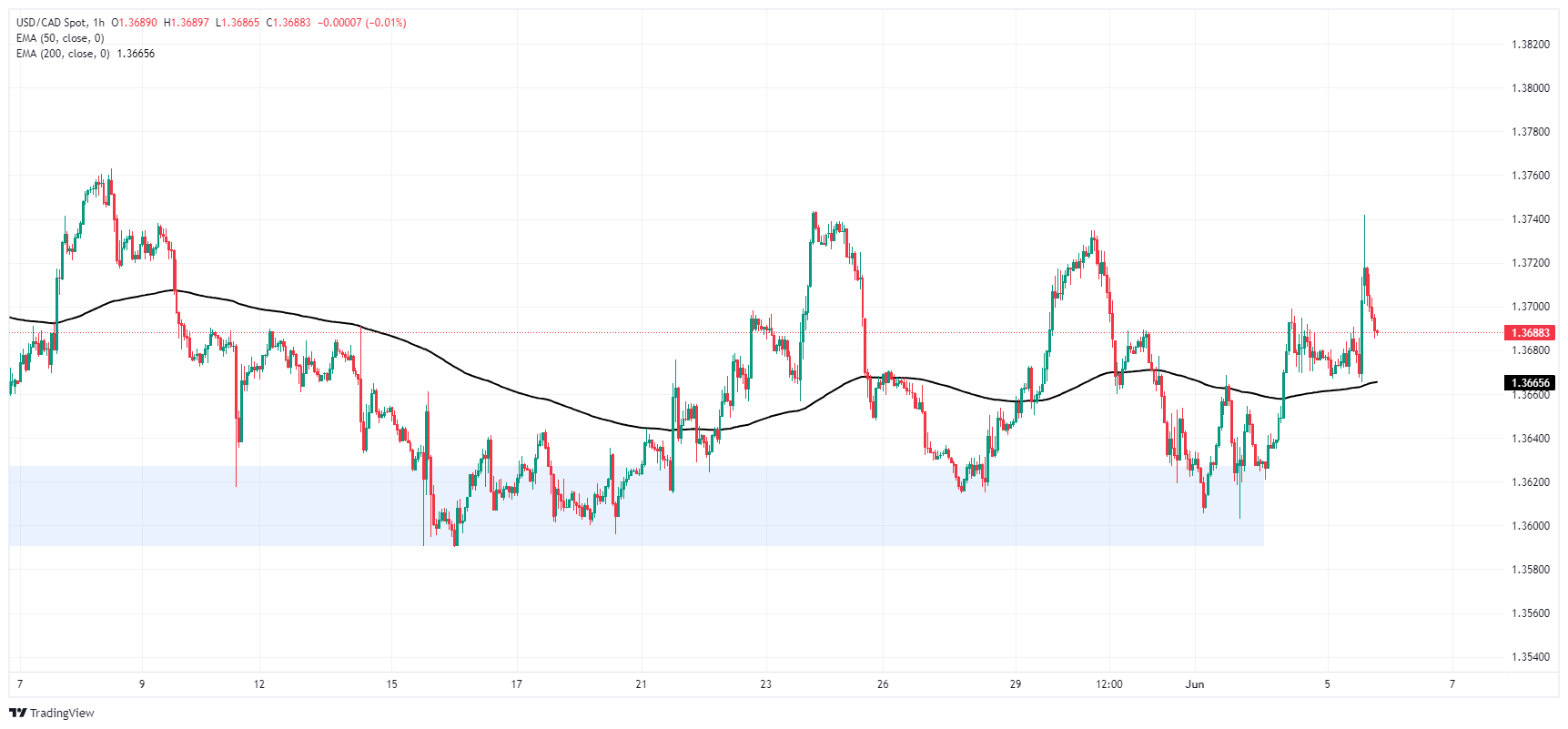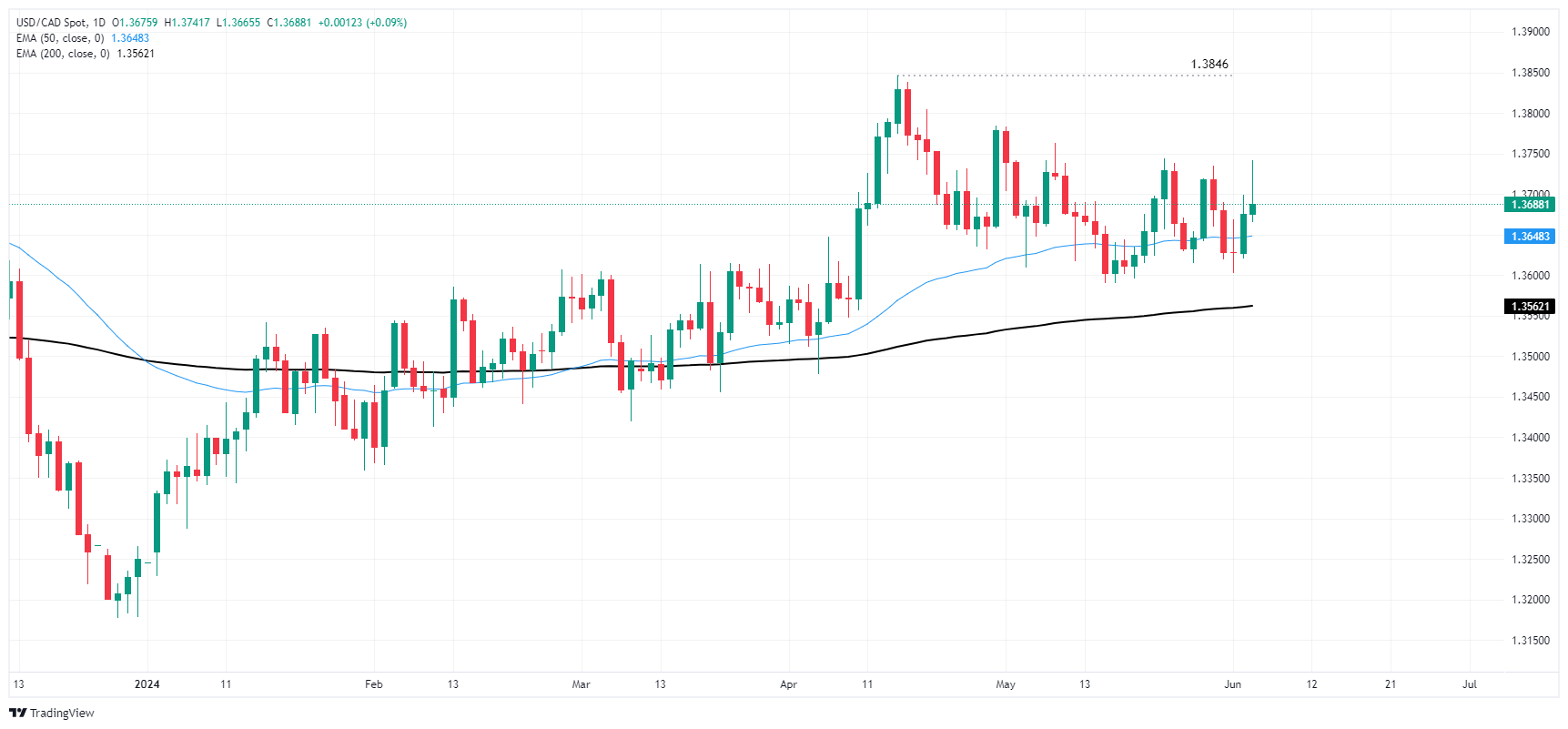- Canadian Dollar loses minor ground against Greenback after BoC rate cut.
- Canada delivers broadly expected rate trim, but BoC sticks to per meeting outlook.
- Markets set to pivot to Friday’s US NFP and Canadian labor figures.
The Canadian Dollar (CAD) backslid against the US Dollar (USD) during Wednesday’s US market session, briefly sending USD/CAD to a near-term high of 1.3740 before markets faded the move back below the 1.3700 handle. The Bank of Canada (BoC) delivered a broadly expected quarter-point rate cut, but US ISM Services Purchasing Managers Index (PMI) figures in June unexpectedly rose to a nine-month high.
Canada has notched a first rate cut from the BoC on Wednesday, and CAD traders will pivot to focus on Friday’s upcoming Canadian labor figures. However, another US Nonfarm Payrolls (NFP) jobs print will likely overshadow Canadian employment data in that session.
Daily digest market movers: BoC moves on rates, meets market expectations
- BoC cut its main reference rate by 25 basis points to 4.75% from 5.0%.
- During the BoC’s Monetary Policy Statement, BoC Governor Tiff Macklem noted that the BoC’s policy decisions on future rate cuts will be considered one meeting at a time.
- US ISM Services PMI rebounds to nine-month high of 53.8 in May, above forecast of 50.8 and recovering from April’s 16-month low of 49.4.
- US ADP Employment Change in May came in lower than expected, printing at 152K in May and missing the 173K forecast. The previous month was also revised slightly lower to 188K from 192K.
- Interest rate market bets of a November Federal Reserve rate cut have risen to 80%.
- BoC's Macklem: Confidence on inflation returning to 2.0% remains in place
- Macklem speech: It is looking like a soft landing for the economy
Canadian Dollar PRICE Today
The table below shows the percentage change of Canadian Dollar (CAD) against listed major currencies today. Canadian Dollar was the weakest against the New Zealand Dollar.
| USD | EUR | GBP | JPY | CAD | AUD | NZD | CHF | |
|---|---|---|---|---|---|---|---|---|
| USD | 0.03% | -0.17% | 0.78% | 0.08% | -0.05% | -0.31% | 0.34% | |
| EUR | -0.03% | -0.21% | 0.73% | 0.04% | -0.07% | -0.32% | 0.29% | |
| GBP | 0.17% | 0.21% | 0.94% | 0.25% | 0.13% | -0.11% | 0.53% | |
| JPY | -0.78% | -0.73% | -0.94% | -0.69% | -0.82% | -1.03% | -0.43% | |
| CAD | -0.08% | -0.04% | -0.25% | 0.69% | -0.12% | -0.37% | 0.27% | |
| AUD | 0.05% | 0.07% | -0.13% | 0.82% | 0.12% | -0.25% | 0.40% | |
| NZD | 0.31% | 0.32% | 0.11% | 1.03% | 0.37% | 0.25% | 0.64% | |
| CHF | -0.34% | -0.29% | -0.53% | 0.43% | -0.27% | -0.40% | -0.64% |
The heat map shows percentage changes of major currencies against each other. The base currency is picked from the left column, while the quote currency is picked from the top row. For example, if you pick the Canadian Dollar from the left column and move along the horizontal line to the US Dollar, the percentage change displayed in the box will represent CAD (base)/USD (quote).
Technical analysis: Canadian Dollar edges lower on Wednesday as Greenback gains
The Canadian Dollar is mixed on Wednesday, rising nearly half a percent against the Japanese Yen but falling around a quarter of a percent against the US Dollar. The CAD’s backslide sparked a brief rise in the pair to 1.3740 before cooler heads prevailed and pushed the pair back toward the 1.37000.
Daily candlesticks reveal the pair mired in near-term congestion with bids waffling close to the 50-day Exponential Moving Average (EMA) at 1.3649. 2024’s high currently sits at 1.3846, while overall USD/CAD remains up around 3.5% for the year.
USD/CAD hourly chart
USD/CAD daily chart
Canadian Dollar FAQs
The key factors driving the Canadian Dollar (CAD) are the level of interest rates set by the Bank of Canada (BoC), the price of Oil, Canada’s largest export, the health of its economy, inflation and the Trade Balance, which is the difference between the value of Canada’s exports versus its imports. Other factors include market sentiment – whether investors are taking on more risky assets (risk-on) or seeking safe-havens (risk-off) – with risk-on being CAD-positive. As its largest trading partner, the health of the US economy is also a key factor influencing the Canadian Dollar.
The Bank of Canada (BoC) has a significant influence on the Canadian Dollar by setting the level of interest rates that banks can lend to one another. This influences the level of interest rates for everyone. The main goal of the BoC is to maintain inflation at 1-3% by adjusting interest rates up or down. Relatively higher interest rates tend to be positive for the CAD. The Bank of Canada can also use quantitative easing and tightening to influence credit conditions, with the former CAD-negative and the latter CAD-positive.
The price of Oil is a key factor impacting the value of the Canadian Dollar. Petroleum is Canada’s biggest export, so Oil price tends to have an immediate impact on the CAD value. Generally, if Oil price rises CAD also goes up, as aggregate demand for the currency increases. The opposite is the case if the price of Oil falls. Higher Oil prices also tend to result in a greater likelihood of a positive Trade Balance, which is also supportive of the CAD.
While inflation had always traditionally been thought of as a negative factor for a currency since it lowers the value of money, the opposite has actually been the case in modern times with the relaxation of cross-border capital controls. Higher inflation tends to lead central banks to put up interest rates which attracts more capital inflows from global investors seeking a lucrative place to keep their money. This increases demand for the local currency, which in Canada’s case is the Canadian Dollar.
Macroeconomic data releases gauge the health of the economy and can have an impact on the Canadian Dollar. Indicators such as GDP, Manufacturing and Services PMIs, employment, and consumer sentiment surveys can all influence the direction of the CAD. A strong economy is good for the Canadian Dollar. Not only does it attract more foreign investment but it may encourage the Bank of Canada to put up interest rates, leading to a stronger currency. If economic data is weak, however, the CAD is likely to fall.
Information on these pages contains forward-looking statements that involve risks and uncertainties. Markets and instruments profiled on this page are for informational purposes only and should not in any way come across as a recommendation to buy or sell in these assets. You should do your own thorough research before making any investment decisions. FXStreet does not in any way guarantee that this information is free from mistakes, errors, or material misstatements. It also does not guarantee that this information is of a timely nature. Investing in Open Markets involves a great deal of risk, including the loss of all or a portion of your investment, as well as emotional distress. All risks, losses and costs associated with investing, including total loss of principal, are your responsibility. The views and opinions expressed in this article are those of the authors and do not necessarily reflect the official policy or position of FXStreet nor its advertisers. The author will not be held responsible for information that is found at the end of links posted on this page.
If not otherwise explicitly mentioned in the body of the article, at the time of writing, the author has no position in any stock mentioned in this article and no business relationship with any company mentioned. The author has not received compensation for writing this article, other than from FXStreet.
FXStreet and the author do not provide personalized recommendations. The author makes no representations as to the accuracy, completeness, or suitability of this information. FXStreet and the author will not be liable for any errors, omissions or any losses, injuries or damages arising from this information and its display or use. Errors and omissions excepted.
The author and FXStreet are not registered investment advisors and nothing in this article is intended to be investment advice.
Recommended content
Editors’ Picks
GBP/USD stays firm above 1.2750 after a landslide Labour victory

GBP/USD keeps its range above 1.2750 in early European session on Friday. The Pound Sterling stays unperturbed by the landslide Labour Party victory in the UK general election while the US Dollar awaits the Nonfarm Payrolls data for fresh directives.
USD/JPY falls hard toward 160.50, US NFP data awaited

USD/JPY is falling hard toward 160.50 in Asian trading on Friday, having reversed from near 161.40. The pair drops on renewed US Dollar weakness and Japanese verbal intervention, which rescues the Yen. The focus shifts to US jobs report.
Gold price steadily climbs back closer to two-week high, focus remains glued to US NFP

Gold price extends its consolidative price move during the Asian session on Friday and remains well within the striking distance of the highest level since June 21 touched earlier this week. The recent softer US macro data reaffirmed market bets that the Federal Reserve will begin cutting rates in September.
Top 3 Price Prediction Bitcoin, Ethereum, Ripple: Bitcoin falls below $56,000 level

Bitcoin breached the weekly support level of $58,375 on Thursday; as of Friday, it is trading 2.8% lower at $55,314. Ethereum and Ripple have dropped below crucial support thresholds, suggesting a potential downtrend for these assets in the coming days.
US NFP: Nonfarm Payrolls forecast to grow by 190K in June as Fed ponders rate-cut timing

With US Federal Reserve Chairman Jerome Powell’s Sintra appearance out of the way, all eyes now remain on top-tier Nonfarm Payrolls data for June, due on Friday at 12:30 GMT.